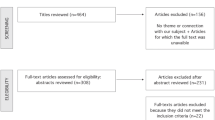Abstract
By a new fractal/transfractal geometry of the Unified Scientometric Model, it is possible to demonstrate that science presents an oscillating or pulsing dynamic. It goes alternatively through two types of phases. Some phases are fractal, with crystalline networks, where the Matthew effect clearly manifests itself with regard to the most notable actors and those that provide the best contributions. The other phases are transfractal, with deformed, amorphous networks, in which the actors, considered mediocre, present greater capacity to restructure the network than the more renowned actors. The result after any transfractal deformation is a new crystalline fractal network. Behind this vision lies the Kuhn paradigms. As examples, the scientific fields of surfactants and autism have been analysed.
Similar content being viewed by others
References
A. J. Lotka, The frequency distribution of scientific productivity. Journal of the Washington Academy of Science, 16(12) (1926) 317–323.
D. J. de Solla Price, Science since Babylon, Yale University Press, New Haven, CT, 1961.
R. K. Merton, Matthew effect in Science. The reward and communication systems of science are considered. Science, 159(3810) (1968) 56–63.
J. R. Cole, S. Cole, The Ortega hypothesis. Science, 178 (1972) 368–375.
J. Ortega y Gasset, La rebelión de las masas, Editorial Tecnos (Grupo Anaya, S. A.), Madrid, 2003.
E. Garfield, Citation analysis as a tool in journal evaluation. Science, 178(4060) (1972) 471–479.
T. S. Kuhn, The Structure of Scientific Revolutions, University of Chicago Press, Chicago, 1962.
A. Rip, J. P. Courtial, Co-word maps of biotechnology: an example of cognitive scientometrics. Scientometrics, 6(6) (1984) 381–400.
B. Latour, Nunca hemos sido modernos: Ensayo de antropología simétrica, Debate, Madrid, 1993.
M. Callon, J. Law, A. Rip, Mapping the Dynamics of Science and Technology: Sociology of Science in the Real World, The McMillan Press LTD, London, 1986.
B. Latour, Ciencia en acción: Cómo seguir a los científicos e ingenieros a través de la sociedad, Labor, Barcelona, 1992.
Callon, M., Representing nature, representing culture. Conference pour l’ouverture du Centre for Social Theory and Technology, 1995.
J. P. Courtial, L. Gourdon, A scientometric approach to autism based on translation sociology. Scientometrics, 40(2) (1997) 333–355.
J. P. Courtial, L. Gourdon, Mapping the dynamics of research on autism or the cultural logic of science. Theory and Psychology, 9(5) (1999) 579–604.
B. Latour, Give me a laboratory and I will raise the world. In: K. Knorr-Cetina, M. Mulkay (Eds), Science Observed: Perspectives on the Social Study of Science. Sage, London, 1983, pp. 141–170.
R. Ruiz-Baños, Ciencimetría de redes. Análisis de la investigación internacional sobre Arqueología mediante el Método de las Palabras Asociadas (1980–1993). Ph. D. Thesis, Universidad, Granada, 1997.
R. Ruiz-Baños, R. Bailón-Moreno, E. Jiménez-Contreras, J. P. Courtial, Structure and dynamics of scientific networks. Part 1: Fundamentals of the quantitative model of translation. Scientometrics, 44(2) (1999) 217–234.
R. Ruiz-Baños, R. Bailón-Moreno, E. Jiménez-Contreras, J. P. Courtial, Structure and dynamics of scientific networks. Part 2: The new Zipf’s Law, the cocitations’s clusters and the model of the presence of key-words. Scientometrics, 44(2) (1999) 235–265.
R. Ruiz-Baños, Las traducciones dinámicas de las series temáticas. Propuesta de una nueva clasificación. Actas del IV Congreso ISKO España EOCONSID’99. La Representación y Organización del Conocimiento en sus distintas perspectivas: su influencia en la Recuperación de la Información, Capítulo Español de la Sociedad Internacional para la Organización del Conocimiento (Ed.), Granada, 1999, pp. 193–198.
B. Latour, S. Woolgar, La vida en el laboratorio. La construcción de los hechos científicos, Alianza, Madrid, 1995.
B. B. Mandelbrot, An informational theory of the stadistical structure of language. In: W. Jackson (Ed.), Communication Theory. London, Butterworths Scientific Publications, 1953, pp. 486–502.
B. B. Mandelbrot, The Fractal Geometry of Nature, Freeman, New York, 1977.
W. Sierpinski, Sur une courbe cantorienne qui contient une image biunivoque et continue de toute courbe donné. Comptes Rendus, (162) (1916) 629.
B. B. Mandelbrot, Adaptation d’un message à la ligne de transmission. I & II. Comptes Rendus, 232 (1951) 1638–1640 & 2003–2005.
B. B. Mandelbrot, Structure formelle des textes et communication (deux études). Word, 11 (1954) 424.
E. N. Lorenz, Deterministic nonperiodic flow. Journal of the Atmospheric Sciences, 20 (1963) 130–141.
G. Julia, Oeuvres de Gaston Julia, Gauthier-Villars, Paris, 1968.
A. F. J. Van Raan, Fractal geometry of information space as represented by co-citations clustering. Scientometrics, 20(3) (1990) 439–449.
A. F. J. Van Raan, Fractal dimension of co-citations. Nature, 347 (1990) 626.
R. Bailón-Moreno, Ingeniería del conocimiento y vigilancia tecnológica aplicada a la investigación en el campo de los tensioactivos. Desarrollo de un modelo ciencimétrico unificado. Ph. D. Thesis. Universidad de Granada, Granada, 2003.
R. Bailón-Moreno, E. Jurado-Alameda, R. Ruiz-Baños, J. P. Courtial, The unified scientometric model. Fractality and transfractality. Scientometrics, 63(2) (2005) 231–257.
R. Bailón-Moreno, E. Jurado-Alameda, R. Ruiz-Baños, J. P. Courtial, Analysis of the scientific field of physical chemistry of surfactants with the Unified Scientometric Model. Fit of relational and activity indicators. Scientometrics, 63(2) (2005) 259–276.
D. J. de Solla Price, A general theory of bibliometric and other cumulative advantage processes. Journal of the American Society for Information Science, 27(5–6) (1976) 292–306.
A. Bookstein, Informetric distributions, Part II: Resilience to ambiguity. Journal of the American Society for information Science, 41 (1990) 376–386.
Author information
Authors and Affiliations
Corresponding author
Rights and permissions
About this article
Cite this article
Bailón-Moreno, R., Jurado-Alameda, E., Ruiz-Baños, R. et al. The pulsing structure of science: Ortega y Gasset, Saint Matthew, fractality and transfractality. Scientometrics 71, 3–24 (2007). https://doi.org/10.1007/s11192-007-1600-8
Received:
Issue Date:
DOI: https://doi.org/10.1007/s11192-007-1600-8




